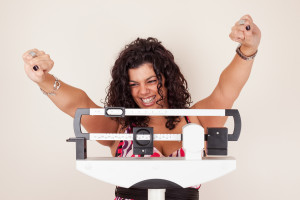 As a woman raising a daughter, you want her to grow into a confident, capable, and healthy woman. After all, in your mind, she is the most beautiful and exceptional girl in the world, and she should realize that too. Understand, however, that your beliefs, attitudes, and comments about your own body are some of the most impactful factors that will dictate how your daughter feels about her own. According to a report by Common Sense Media, five to eight-year-olds who think their mothers are unhappy with their bodies are more likely to feel dissatisfied with their bodies in return. With swimsuit season quickly approaching, now more than ever, learn to break the habit of negative self-image talk and be the confident woman you hope your daughter will be one day too. Keep reading for five tips for learning to be body positive.
As a woman raising a daughter, you want her to grow into a confident, capable, and healthy woman. After all, in your mind, she is the most beautiful and exceptional girl in the world, and she should realize that too. Understand, however, that your beliefs, attitudes, and comments about your own body are some of the most impactful factors that will dictate how your daughter feels about her own. According to a report by Common Sense Media, five to eight-year-olds who think their mothers are unhappy with their bodies are more likely to feel dissatisfied with their bodies in return. With swimsuit season quickly approaching, now more than ever, learn to break the habit of negative self-image talk and be the confident woman you hope your daughter will be one day too. Keep reading for five tips for learning to be body positive.
- Accept that What You See in the Media is Not a Standard to Which You Should Aspire. Your Pinterest, Instagram, and Facebook feeds are likely full of images of celebrities, social media personalities, and even acquaintances who appear to be thinner, fitter, and happier than you. Remind yourself that what you see is only a curated compilation of moments in time and that you don’t have to be waiflike to be happy—because most women aren’t rail thin, and those who are, may not be healthy, or nearly as happy as they appear in your social stream.
- Talk to Your Body Like It’s Your Friend. If your friend were having a bad day, and feeling bad about herself, you wouldn’t agree or toss further insults at her. You’d pick her back up on her feet and remind her of all of her unique qualities. Do the same for your body. After all, you’re going to be together for a long time.
- Spread Your Positivity Around. If you find yourself criticizing yourself, that negativity could manifest into how you perceive others as well. Don’t let yourself become so obsessed with weight, body types, or small insignificant physical details that you find yourself thinking (or saying!) negative comments about other people’s bodies. By remaining positive about others, you will find ways to be positive about yourself. And by being positive about yourself, you will effortlessly be positive about others. It’s a happy cycle.
- Forgive Yourself. If you are trying to eat healthily, go to yoga class, and drink plenty of water, but find it’s not always easy to be consistent while you are running around after your toddler and doing double duty as a mom and a dedicated employee, give yourself a break. Cheat on your diet one day? Forgive yourself and recommit tomorrow. Haven’t seen the scale budge in weeks? Don’t let that be a reason to stop trying to make healthy choices. Forgiveness is an essential predecessor to acceptance, which is a critical step toward happiness.
- Surround Yourself with Positive People. The people in your life can have a detrimental impact on your happiness if they are highly critical, self-deprecating, and unsupportive. You don’t need that level of negativity in your life. By surrounding yourself with people who share your values and appreciation for maintaining a positive body image, you will find that even on a bad day, you have the motivation to remain positive.
Remember, your body image doesn’t only impact you; it affects your daughter too. Be the confident, accepting woman you want your daughter to be, and you’ll both live happy, healthy lives.
More
 The culmination of pregnancy sneaks up on new parents. The first few weeks are filled with eating, sleeping and many diaper changes! Schedules may be difficult to establish until your baby is a few months old. However, routines can be created in the first few weeks. Routine can help mommy and baby adjust to their new life and create healthy sleep patterns. Here are a few things to expect during those first few weeks of life.
The culmination of pregnancy sneaks up on new parents. The first few weeks are filled with eating, sleeping and many diaper changes! Schedules may be difficult to establish until your baby is a few months old. However, routines can be created in the first few weeks. Routine can help mommy and baby adjust to their new life and create healthy sleep patterns. Here are a few things to expect during those first few weeks of life.
Feeding
Feeding represents, perhaps, the most important time for newborns. It’s normal for newborns to spend to two to five hours per day eating. Newborns typically eat six to eight times per day. Breast-feeding allows for the important development of mother and baby bonding. Bottle-feeding can also provide ample bonding time for the other parent.
Sleeping
Sleeping will inevitably be a challenge with a newborn. The good news? The worst part only lasts for three months, on average. By month four, most babies can sleep at least 5-6 hours at a time. For the first three months, consider scheduling sleep with your partner; determine times where one parent is on duty and the other can sleep. Additionally, aim to match your sleep habits with the baby. Sleep/nap when the baby sleeps. Don’t feel like you need to be the host, if family comes over, take that time to catch up on some rest, while they watch your new baby.
Bathing
Bathing newborns can also pose a trial. For the first week or two, until the umbilical cord stump falls off, sponge baths are recommended. Newborns only need to be bathed three times per week, as many will struggle with sensitive and dry-skin issues. Expect baths to become more frequent, as the baby gets older. Try to set bath time in the schedule around the same time each day to eventually lead to more consistency with sleep patterns. A bath at nighttime will help the child relax and anticipate bed time.
Play
Remember to make time for playing too. Playing is an important time that helps your newborn developmentally. Activities can include taking walks, reading stories, talking, or singing a song to your new baby.
Make time to cherish these first few weeks. And if you’re ever feeling depressed, sad or lonely, reach out for help. The doctors at Chouchani, Sayegh and Robinson are also here to help you through the adjustment of becoming a new mommy.
More
 Stress can even cause heart palpitations. Less common physical symptoms of stress can include elevated blood pressure, rapid breathing, eyesight difficulty, thirst/hunger, dizziness, nausea, excessive sweating, weakness, fainting, and chills. Additionally, stress can also lead to mouth and jaw pain, especially for people with a tenancy to clench or grind their teeth.
Stress can even cause heart palpitations. Less common physical symptoms of stress can include elevated blood pressure, rapid breathing, eyesight difficulty, thirst/hunger, dizziness, nausea, excessive sweating, weakness, fainting, and chills. Additionally, stress can also lead to mouth and jaw pain, especially for people with a tenancy to clench or grind their teeth.
To combat stress, there are many things you can do. The following are some ideas to help you better cope with stress and reduce the negative impact it can have on your body.
Get Enough Exercise
Yes, it’s true, exercise is the answer to many physical problems affecting women. In order to combat stress symptoms, aim for at least 20 minutes of continuous exercise per day, though 30 minutes is better. If you are busy after work with a family, consider re-purposing your lunchtime for a walk. If the weather is nice, get outside. Fresh air and sunlight can also help reduce overall stress symptoms. Ideal exercises will include walking, jogging, swimming, biking, and yoga, which release endorphins and increase your mood.
Learn to Meditate
Make time each day for meditation and breathing exercises. Yoga is an ideal way to blend exercise and meditation together. Through focusing on syncing breath and movement, yoga helps your brain release stressful thoughts. Additionally, yoga can be practiced at home on a variety of apps and YouTube channels. All you need is a yoga mat and comfy clothes. If yoga isn’t your thing, consider more stationary breathing or guided meditation practices. There are plenty of guided meditations available through apps or YouTube. Breathing exercises help your brain release stressful thoughts by switching your focus and concentration to breathing. Short three to five minutes deep breathing exercises can help relieve stress. If you have trouble turning off your brain for sleep, consider guided meditations designed for sleep.
Maintain a Healthy Diet
A healthy diet doesn’t mean you have to be on a “diet,” it means you have to make mindful choices every day. Choose whole foods such as fruit, vegetables, yogurt, and nuts instead of processed foods loaded with sugar. Sugar and caffeine both aggregate stress. While quitting cold turkey won’t work for everyone, consider limiting sugar and caffeine intake. Also, be mindful of the time of day you are ingesting sugar or caffeine. Eating dessert right before bed may lead to sleep issues because your body doesn’t have time to digest the food. If you rely on morning coffee, try to cut back on the amount of flavored syrup or added sugar over time.
Strive to Achieve a Work-life Balance
Look for small ways to find a better balance between your work and at-home life. For some women, these sectors of life may overlap due to working from home or owning your own business; however, finding ways to separate and compartmentalize these areas can reduce stress overall. Make a schedule and stick to it. Limit work to certain hours of the day, making time for your loved ones.
Limit Technology Use
As a society, we are connected to our phones, computers and tablets. Similar to defining a work-life balance, also work on developing a technology-life balance. Limit emails and calls to predetermined hours. Look for ways to incorporate and stick to technology-free periods. While texts and emails may appear to be of paramount importance, take a step back and examine what really matters in life. Spending time with loved ones will help reduce stress.
More
 How to Keep Your Newborn Safe and Avoid the Risk of Sudden Infant Death
How to Keep Your Newborn Safe and Avoid the Risk of Sudden Infant Death
It is a nightmare that no parent should have to face. In the early days of your newborn’s life, when every breath is precious, and every decision is made with the utmost care for their safety and well-being, the idea that a child could lose her or her life in sleep is a devastation that is impossible to understand. In reality, according to the Centers for Disease Control and Prevention (CDC), in 2015, there were approximately 1,600 deaths due to Sudden Infant Death Syndrome (SIDS). 1,200 of the deaths were due to unknown causes, while about 900 were due to accidental suffocation and strangulation in bed.
Every parent wants to keep his baby safe—day and night. By remaining informed about the risks and potential causes of SIDS, you can help to minimize the risk to your child.
How to Minimize the Risk of SIDS in Your Home
Put your baby on his back during sleep and nap times. This long-held recommendation is still believed to be vital, as it increases his access to fresh air and reduces the chances of him overheating in the night, a known SIDS risk factor.
- Place baby in a bare crib with a firm mattress. Do not place bumper pads or other positioning devices, pillows, blankets, covers, or stuffed animals in the crib with your baby. Any items that can affect the baby’s re-breathing (breathing back in the air that was just breathed out) can affect your baby’s arousal, or his ability to wake up if in distress.
- Stay awake while feeding at night. Late night feeding sessions can be exhausting, but never fall asleep while breast or bottle feeding your baby. Make sure to put him back to bed safely when done to ensure he does not suffocate or choke.
- Offer baby a pacifier. If you are breastfeeding, once your baby can breastfeed, offer a pacifier. Make sure the pacifier is not attached to the baby or the crib in any way, as this could cause a choking hazard.
- Do not allow bed sharing. Never fall asleep with your baby in your bed, on a sofa, or in a chair. If your baby rolls in a way so that his mouth and nose are covered, he may not have the strength to reposition himself to obtain adequate oxygen. Also, do not allow your baby to share a bed with other infants of children in your household. Here are other sleep safety tips for newborns.
- Put baby to bed in your room. Keep your baby’s crib in your bedroom until he is about six months old and can roll over on his own. That way, you can be immediately available if you hear any indication that your baby is in distress.
- Make sure baby’s clothes won’t make him overheat. The clothes you put on your baby at night should keep him warm but should ensure he is not at risk of overheating. The temperature of your room is also a factor to help baby be comfortable during nap and sleep times.
- Do not smoke. Smoking exposes your baby to lung-damaging cigarette toxins.
- If you are able, breastfeed. Studies show that breastfed babies are typically healthier and more well rested.
- Encourage supervised tummy-time. Babies need to learn how to use their arms and core to lift their upper bodies off the ground. Plan for frequent sessions of supervised tummy time to give your baby a chance to work on these skills, but never in a crib or on a bed—always on a flat surface.
- Make sure you have a safe environment for baby when traveling. Call ahead to ensure the hotel has a crib you can use if you are not able to bring your own.
If you have observed even one incident in which your baby appeared not to be breathing, went limp, or turned blue, or if your baby gags excessively after spitting up, talk to your doctor or call 9-1-1 at once. If you have any other concerns regarding your baby or how to minimize the chance of SIDS, do not hesitate to speak with your doctor.
More
 So, you decided that you need to lose some weight? It sounds overwhelming, but it doesn’t have to be. Our society leads us to believe that if we want to lose weight we have to do something drastic, like only eat protein, workout for hours a day, do a juice cleanse, go on a fad diet, or reduce our calorie intake to 1200 calories per day. Most of these drastic attempts to lose weight result in a way of life that is near impossible to sustain. And most of them are unhealthy.
So, you decided that you need to lose some weight? It sounds overwhelming, but it doesn’t have to be. Our society leads us to believe that if we want to lose weight we have to do something drastic, like only eat protein, workout for hours a day, do a juice cleanse, go on a fad diet, or reduce our calorie intake to 1200 calories per day. Most of these drastic attempts to lose weight result in a way of life that is near impossible to sustain. And most of them are unhealthy.
Slow and Steady Wins the Race
Sure you might try a fad diet and drop 20 pounds in a month. Great right? Not really, if you don’t change your lifestyle and get rid of unhealthy habits, chances are you will gain all of that weight back plus some more in the months to come.
So what works? Lower amounts of weight loss (1-2 pounds a week) over a long amount of time is the best method. The way you can achieve long term results is by focusing on making changes that you can sustain over the long term.
How? Start with this list of easy tweaks you can make to help you lose the weight and keep it off for good!
10 Small Steps to Weight Loss
- Eat your veggies. Yes, your mom told you to eat your broccoli and she was right! Veggies have very low calories (almost none) and fill you with many different nutrients and satisfying fiber. If plain veggies sound blah to you, dip them in hummus or non-sweetened Greek yogurt (which you can add flavor to by mixing in herbs and spices).
- Fuel up with fruit. Craving ice cream or candy? Fruit is nature’s candy. When you are craving something sweet, grab and apple or munch on some frozen grapes or berries. If you must have some chocolate, melt some dark chocolate and dip in a few strawberries. Your calorie consumption will be much less and you won’t feel like you’re missing out.
- Cook at home. When you cook your own meals, you save on calories, avoid huge portion sizes and you know exactly what is going into your food. Planning your meals and grocery shopping ahead of time will help you stick to your plan during those hectic weekdays. In addition, if you are going to work, pack your lunch instead of eating out.
- Make smarter food swaps. Taco Tuesday? Swap out fat laden beef with lean ground chicken or turkey. Ditch your burrito shell and make a taco salad with a few tortilla chips crumbled over the top to get a satisfying crunch. Swap regular white bread for whole grain bread. Eat an English muffin instead of a bagel. For almost any food, there is a healthy alternative. You get the idea!
- Move every single day. Obviously, exercise is an important part of any weight loss journey. You don’t have to log long hours at the gym. If you’re first starting out, you might want to begin by walking. Strive for 10,000 steps a day. Get a pedometer or use your smart phone to log your steps. Get a buddy to meet you at the gym so that you’ll be held accountable. Join a class or take up swimming. Dance in your living room! Whatever you like to do, make it a point to move every day.
- Limit your alcohol consumption. Not only do alcoholic drinks have massive amounts of empty calories, drinking also impairs your judgement and may lead you to make poor food choices or overeat.
- Be cognizant about your portion sizes. Measure your portions or use a smaller plate at dinner time.
- Ditch the soda. A can of soda can have upwards of 150 calories. A few glasses of soda per day and you’ll be packing on the pounds. Even diet soda has been linked to obesity. Instead, fill your glass with water or sparkling water to get those bubbles you crave.
- Drink more water. Drink water throughout the day and a full glass a half hour before you eat. You’ll feel fuller earlier and water keeps everything moving and in working order.
- Keep a food journal. Just the act of writing down what you are eating daily will help you become accountable to what you are feeding your body. It will also help you to identify how to make better choices. Free apps such as MyFittnessPal or paid apps like Weight Watchers can help you track your food and activity.
You don’t have to do everything on this list at once!
There are a lot of reasons why you might need to lose weight. Whether you’re trying to fit into your skinny jeans again, lower your cholesterol, decrease your risk of Type II diabetes or improve your overall energy level. Pick one or two items on this list and work on them for a few weeks. Once you’ve mastered that goal, add in another lifestyle change.
Share your results with our community by posting a response below. Or share other ideas on how to achieve long term results!
More
 Endometriosis is a painful reproductive disease that affects 176 million women across the globe. It is the leading cause of infertility, and chronic pelvic pain, and has been linked to other such complicated and painful conditions as adenomyosis, fibroids, interstitial cystitis, some cancers, and other autoimmune disorders. For the millions of women who suffer painfully with endometriosis, each year we recognize the month of March with a focus on endometriosis education and awareness. Together, with more knowledge of this painful condition and more support for treatment research, we can all work together toward an eventual cure and can start to reduce the number of women suffering from this disease.
Endometriosis is a painful reproductive disease that affects 176 million women across the globe. It is the leading cause of infertility, and chronic pelvic pain, and has been linked to other such complicated and painful conditions as adenomyosis, fibroids, interstitial cystitis, some cancers, and other autoimmune disorders. For the millions of women who suffer painfully with endometriosis, each year we recognize the month of March with a focus on endometriosis education and awareness. Together, with more knowledge of this painful condition and more support for treatment research, we can all work together toward an eventual cure and can start to reduce the number of women suffering from this disease.
What is Endometriosis?
Endometriosis occurs when uterine tissue, known as the endometrium, develops outside of the uterus. Often, the tissue grows inside the pelvic cavity and around the reproductive organs, such as the ovaries, uterus, and fallopian tubes. It may also develop around the uterosacral ligaments, the peritoneum, or in the areas between the rectum, uterus, and vagina, or bladder. In more rare occurrences, the endometrium may develop around the appendix, bladder, bowels, intestines, or rectum.
Doctors do not know what ultimately causes the growth of the endometrium outside of the uterus. This internal condition often goes unnoticed or misdiagnosed and mistreated when it presents itself in the form of painful periods.
Signs and Symptoms
Symptoms of endometriosis may include:
- Painful periods that include pelvic cramping that begins before your period and lasts after it has ended.
- Lower back and abdominal pain that accompanies the pelvic pain surrounding menstruation.
- Pain during or after sex.
- Pain during urination and bowel movements, particularly during menstruation.
- Extremely heavy period bleeding (known as menorrhagia), or bleeding between periods.
- Infertility.
- Fatigue.
- Diarrhea or constipation.
- Bloating or nausea, particularly during menstruation.
Diagnosis and Treatment
Too often, women do not question the pain they experience during their periods or sex. Sometimes they mistakenly assume the discomfort is normal, or they are uncomfortable discussing their symptoms with their doctor. For this reason, endometriosis often goes undiagnosed and untreated until women are trying to get pregnant and experience infertility complications. If you are suffering from any of the symptoms above, and believe you may have developed endometriosis, talk to your OBGYN. He or she will diagnose the cause of your pain because no woman should have to suffer in silence.
Supporting Endometriosis Awareness Month
If you or a loved one are suffering from endometriosis, its painful symptoms, or its infertility complications, there are ways to become involved with efforts to raise support and awareness this month. On March 24, a worldwide Endometriosis March will take place in cities around the world. Visit endomarch.org to find a march near you, or for more information on becoming involved with support efforts in your community.
More
 March is National Colorectal Cancer Awareness Month. According to the American Cancer Society, colorectal cancer, or cancers of the large intestine (colon) and rectum, is the third most common cancer diagnosed in both men and women in the United States, excluding skin cancer. Researchers estimate that we will see over 97,000 new diagnosed cases of colorectal cancer in 2018 alone. While the risk of developing colorectal cancer is slightly higher for men (4.5%) compared to women (4.2%), both men and women should be aware of the risks of this deadly disease and its side effects. All adults should further efforts of early detection by receiving a colonoscopy based on age and gender-appropriate recommended screening guidelines. This March, commit to your health and talk to your doctor about your risks for colorectal cancer and when you should obtain your next screening.
March is National Colorectal Cancer Awareness Month. According to the American Cancer Society, colorectal cancer, or cancers of the large intestine (colon) and rectum, is the third most common cancer diagnosed in both men and women in the United States, excluding skin cancer. Researchers estimate that we will see over 97,000 new diagnosed cases of colorectal cancer in 2018 alone. While the risk of developing colorectal cancer is slightly higher for men (4.5%) compared to women (4.2%), both men and women should be aware of the risks of this deadly disease and its side effects. All adults should further efforts of early detection by receiving a colonoscopy based on age and gender-appropriate recommended screening guidelines. This March, commit to your health and talk to your doctor about your risks for colorectal cancer and when you should obtain your next screening.
Signs and Symptoms of Colorectal Cancer
You may be diagnosed with colorectal cancer if you experience any of the following symptoms:
- A change in bowel habits that could include diarrhea, constipation, or a narrowing of the stool that lasts for more than a few days.
- A feeling that you need to have a bowel movement that is not relieved by having one.
- Rectal bleeding.
- Blood in the stool that may give it a dark appearance.
- Abdominal pain, cramping, or gas.
- Weakness or fatigue.
- Weight loss.
The Importance of Receiving a Recommended Colonoscopy
Colorectal cancer is one form of cancer that can be prevented in some instances. A colonoscopy can identify cancer-indicating polyps so they can be removed before they evolve into cancerous cells. During the colonoscopy procedure, your doctor will examine your entire colon and rectum using a hollow, flexible, lighted tube with a tiny video camera affixed to the end. Once inserted, your doctor will use the camera to examine your colon for polyps, which, if found, can be removed during the procedure, immediately reducing your chances of a polyp developing into colorectal cancer.
When Should You Obtain a Screening?
Talk to your doctor about your unique health risks and about when and how frequently you should obtain a colonoscopy. The United States Preventative Task Force and the American Cancer Society recommend that men and women should receive a colorectal cancer screening starting at age 50, and every ten years after that until they reach age 75. If you are at a higher known risk for colorectal cancer based on family history, a personal history of an inflammatory bowel disease, or other risk factors, your doctor may recommend receiving your first colonoscopy before age 50. Follow this link for more information about colorectal cancer screening recommendations from the American Cancer Society.
Encourage the Men in Your Life to Get Tested
While both men and women should receive regular colorectal cancer screenings in consultation with their doctor, women should encourage the men in their lives to be tested. Due to perceptions of the uncomfortable nature of the exam and its necessary preparatory work, some men tend to be apprehensive and choose to procrastinate regular colonoscopy screenings. Remind the men in your life of the importance of early detection, the risks that men face, and how much you need them to live a long and healthy life with you.
If you believe you may be at a risk of developing colorectal cancer, or if you believe you may already be experiencing symptoms, talk to your doctor today.
More
 Over the past few years, probiotic has certainly become a buzz word in the world of women’s health. Many different types of probiotics, with various claims to improve your overall health, are lined up on the shelves of your local pharmacy and grocery stores – and targeted to you through ads on google or Amazon.com. With all this excitement over probiotics, you may be thinking; do I need to take a probiotic supplement?
Over the past few years, probiotic has certainly become a buzz word in the world of women’s health. Many different types of probiotics, with various claims to improve your overall health, are lined up on the shelves of your local pharmacy and grocery stores – and targeted to you through ads on google or Amazon.com. With all this excitement over probiotics, you may be thinking; do I need to take a probiotic supplement?
First things first, what are probiotics?
Probiotics are live bacteria which are like the beneficial microorganisms naturally found in the human gut. They help you to digest food, produce vitamins and destroy bad microorganisms which can be detrimental to your health. A healthy balance between good and bad bacteria is essential to digestive health and your immune system.
What are the benefits of probiotics?
- Probiotics may help support a healthy immune system. Since roughly 70% of the body’s immune system resides in the walls of your gut, it’s important to keep it healthy. Ingesting probiotics may help protect against infection, including the common cold and the flu.
- Probiotics may help support weight loss. Recent studies have found a link between probiotics and body weight. The idea is that probiotics help the body break down and digest fiber. Taking the supplements alone will not result in weight loss. Some people decide to pair probiotics with cutting calories and increasing exercise to maximize weight loss efforts.
- Probiotics may help your gut recover after taking antibiotics. If you’ve ever taken a course of antibiotics and wound up with diarrhea or a yeast infection, it’s because the antibiotics destroyed the good and the bad bacteria, throwing your digestive system off kilter. Taking a probiotic supplement may help to ease side effects of antibiotics.
- Speaking of bathroom issues, probiotics may help prevent travelers’ diarrhea. Taking probiotic supplements that contain Lactobacillus acidophilus, Lactobacillus sporogenes, Bifidophilus bifidum, or Sacchromyces boulardii when traveling may help prevent bathroom emergencies.
- Probiotics may improve your skin. Probiotics may help treat common skin issues and improve eczema and psoriasis. Probiotics may also contribute to healthier skin by defending against wrinkles, sun damage, and dryness.
- Probiotics may support a healthy feminine flora. Lactobacilli (good bacteria) protect your vagina. If your good bacteria is compromised you may experience conditions such as a yeast infection or bacterial vaginosis. Some types of probiotics help control common feminine issues. Microbes can help keep the vaginal area acidic, creating a hostile environment to infectious bacteria.
Should you take a probiotic supplement?
Not necessarily! The most beneficial probiotic bacteria are called Lactobacillus and Bifidobacteria and you don’t need to get them from probiotic supplements. In fact, dietary sources of probiotics include types of yogurt, cheese and other dairy products should be sufficient enough to support a healthy gut.
What foods are high in naturally occurring probiotics?
- Yogurt is an excellent source of probiotics. Check for the “Live and Active Cultures” seal on the product label.
- Cheese can also include a good amount of probiotics. Goat milk, sheep milk and soft cow milk varieties of cheese typically include vast amounts of probiotics.
- Apple cider vinegar is made from fermented apple juice. Many fermented foods are high in probiotics.
- Unpasteurized kimchi and sauerkraut also contain probiotics because they are made in a fermentation process.
- Kombucha, a trendy tea drink, uses fermented black or green tea. The process of fermenting the tea adds bacteria and yeast, which account for the probiotics.
Scientists are still studying the benefits of probiotics and how much you’re really getting from supplements. Therefore, you may not need a supplement if you get enough “good bacteria” in your natural diet.
And remember, while probiotics may help the conditions mentioned above, proceed with caution and talk to your doctor if you have any of the following issues:
- A weakened immune system or get infections often.
- Food allergies or sensitivities, especially to dairy.
- If you are taking antibiotics that affect your immune system.
Still wondering if you should take a probiotic supplement? Talk to your doctor.
More
 Even if you didn’t have an established exercise routine, moms-to-be should begin incorporating activity into your lifestyle. Staying active and healthy is not only great for the moms, but also for the baby. Below are the best exercises to preform while pregnant.
Even if you didn’t have an established exercise routine, moms-to-be should begin incorporating activity into your lifestyle. Staying active and healthy is not only great for the moms, but also for the baby. Below are the best exercises to preform while pregnant.
Walking, yes, walking!
The benefits of walking are underrated. While it’s a monotonous part of everyday life, walking represents an easy way to begin a healthy routine. A main benefit is that it’s easy and free! No gym membership, expensive equipment, or gear required.
How much? Start off by shooting for a minimum of 15-20 continuous minutes per day, while working up to 30-45 minutes per day. With the endless variety of step counter apps and products, it’s easy to monitor your pace and distance.
New to walking? If so, aim to walk one mile per day for the first couple weeks, then increase to 1.5 miles per day to reach approximately 30 minutes total. It’s best to perform all 30 minutes at once, but many studies point to a minimum of 10 minutes at a time to see improved health. So, splitting it up into three 10-minute sessions throughout your day will also work! Take advantage of 15-minute breaks at work and go out for a stroll around your office.
Is it safe? Yes, walking is low-impact and safe for nearly everyone! Be sure to have proper footwear and plenty of water.
 Swimming and Water Aerobics
Swimming and Water Aerobics
Water sports are great because the water eases impact and soothes the body. Some prior knowledge of swimming is helpful to get started. Prenatal water exercises build core strength and contribute to an overall active lifestyle.
How much? It’s best to hit the water at least three times per week for 30 minutes to see and feel increased health benefits. Once you get going, five 30-minute sessions per week is ideal.
New to swimming? Join a gym with swim classes or find a personal coach. It might be fun to practice in prenatal groups with professionals to guide you.
Is it safe? Yes, swimming is a low-impact exercise that is safe during the prenatal and first-trimester periods. Be safe and swim with others!
Yoga
If you are looking to find a mind/body balance, yoga is the answer. By focusing on combining aspects of stretching, aerobic-type exercises, and deep breathing, yoga can help reset and quiet your mind, while toning your body.
How much? Most studio yoga classes are 60-75 minutes, so three times a week should be plenty. If you are an experienced yogi, practicing at home at home is an option as well. Look online for free videos in the 30-minute range. Aiming for 30 minutes per day would be most beneficial.
New to yoga? Until you’ve mastered the basic moves, it’s recommended to start at a studio where instructors can help fix and guide your alignment in poses. Once you are experienced, it’s inexpensive and easy to practice at home. All you need is access to a TV or computer and a yoga mat. If you have limited flexibility, consider investing in two yoga blocks and a strap to help make poses accessible.
Is it safe? Yes, but keep in mind not all poses will be accessible to you during pregnancy. Avoid backbends, twits, and headstands. Hot yoga is also not recommended. Many gyms offer, or even specialize in, prenatal and pregnancy-focused classes. And many teachers can give you modified poses if they are aware that you are pregnant.
Stationary Bikes/Cycling
If you are looking for a cardio fix to keep the blood pumping, consider a stationary bike or spin-class gym membership. While bicycles are a low-impact exercise, it’s recommended to limit riding to stationary bikes during pregnancy due the dangers of the open road.
How much? If you own a stationary bike, try for 30 minutes per day to remain active and healthy. However, if you plan to hit spin classes or open gym time, three sessions are ideal.
New to cycling? It’s never too late to learn how to ride a bike, especially a stationary bike. Just hop on and start peddling. Consider investing in a stationary bike, as it’s typically a less expensive long-term investment than a gym membership. If you are on a budget, check garage sales and online for-sale websites to find a used model. Owning your own bike will save the time and effort it takes to get yourself to the gym.
Is it safe? Yes, but don’t push yourself too far. Avoid super competitive spin classes; look for prenatal or pregnancy friendly classes when possible. You can always back off if need be and stay seated instead of standing during class. Something to keep in mind—your center of gravity can shift during pregnancy, so take it slow and be safe.
Overall Tips for Exercising When Pregnant
Keep in mind, you may be tired or nauseous, so take it easy. Start slow and build up to your desired workout goals.
- Stay hydrated. You and your baby need fluids, so fill up the large water bottle before you head out.
- Wear the correct footwear or attire to stay safe. While swimming and yoga are practiced barefoot, cycling and walking require proper athletic shoes.
- Don’t be scared to ask an expert. Lack of experience is no reason to be sedentary during pregnancy. Look for a pregnant-friendly gym or yoga studio and find qualified instructors to help you get fit. Odds are you’ll also meet like-minded woman and make some friends.
- Talk to your doctor. Above all else, when in doubt, consult your doctor.
More
 This year’s flu season is on track to be the worst in nearly ten years—and it’s nowhere near over yet. According to a recent report by the Washington Post, Tens of thousands of Americans have been hospitalized so far, and 37 children have lost their lives battling this season’s flu epidemic. If you have been hesitant to get vaccinated, it’s time to reassess the reasons why the Centers for Disease Control and Prevention (CDC) and your doctor recommend the flu vaccine, and how it can minimize your chances of being another victim of this year’s dangerous flu strain.
This year’s flu season is on track to be the worst in nearly ten years—and it’s nowhere near over yet. According to a recent report by the Washington Post, Tens of thousands of Americans have been hospitalized so far, and 37 children have lost their lives battling this season’s flu epidemic. If you have been hesitant to get vaccinated, it’s time to reassess the reasons why the Centers for Disease Control and Prevention (CDC) and your doctor recommend the flu vaccine, and how it can minimize your chances of being another victim of this year’s dangerous flu strain.
What are the Symptoms of the Flu?
Flu symptoms tend to come on quickly and unexpectedly. If you experience any of the following symptoms, you may have contracted the flu. See your doctor as soon as possible for a diagnosis and treatment:
- Fatigue and weakness
- Severe muscle and joint pain
- Fever, flushed skin
- Headache
- Dry cough
- Red, watery eyes
- Sore throat
- Runny nose
- Vomiting or diarrhea, often more common in children than adults
If you have any of the following symptoms, seek medical care immediately, as they could be an indication of a severe flu virus:
- Difficulty breathing
- Pain in your chest or abdomen
- Sudden dizziness
- Difficulty focusing
- Severe vomiting
What are the Benefits of the Flu Vaccine?
The CDC advises that the single best way to protect yourself from both falling ill from the flu and serving as a carrier is to get the flu vaccine each year. Approximately two weeks after the vaccine is administered, antibodies are developed in the body that protect against infection using the viruses in the vaccine. It is important to obtain a flu vaccine annually, because each year, the distributed vaccine is designed to guard against those virus strains that researchers believe will be most prevalent during the coming flu season. The more Americans who obtain a vaccination, the less the virus can spread across communities.
Isn’t It Too Late to Get Vaccinated Now?
You do not need to obtain a flu vaccine at the start of the flu season to be protected. While the flu season is typically considered to begin in October and last through May, obtaining a vaccine at any time during the flu season can still protect you and minimize your chances of becoming ill or spreading the illness to others.
I’m Pregnant. Can I Get the Flu Vaccine?
Pregnant women should be vaccinated against the flu, as it is their best form of protection against the virus. The flu can cause even more complications and severe symptoms in pregnant women. When pregnant, changes to your immune system, heart, and lungs make women more susceptible to viruses and infections such as the flu, which can result in hospitalization, and—in the most severe cases—death. The flu vaccine protects pregnant women during and after their pregnancy, and it also protects the baby from contracting the virus for several months after birth.
What Else Can I do to Prevent the Flu?
In addition to obtaining a flu vaccine, follow these tips to minimize your chances of contracting the flu:
- Avoid exposures to anyone who is sick.
- Wash your hands regularly with soap and water.
- Do not touch your eyes, nose, or mouth, as you could transfer germs you picked up on your hands into your body.
- Keep surfaces in your home and office clean and disinfected.
- If you have children who go to school, keep items that travel from the classroom to the house sanitized as well, such as toys, lunch bins, and other objects.
- Take care of yourself by getting plenty of rest, drinking plenty of water, eating a balanced diet of fresh, healthy foods, staying physically active, and managing stress.
If you do contract the flu virus, be diligent not to spread the vaccine to others. Stay home, do not go to work, cover your nose and mouth when you sneeze or cough, and avoid contact with others.
If you feel you may have contracted this year’s flu strain, contact your doctor for an appointment.
More
 As a woman raising a daughter, you want her to grow into a confident, capable, and healthy woman. After all, in your mind, she is the most beautiful and exceptional girl in the world, and she should realize that too. Understand, however, that your beliefs, attitudes, and comments about your own body are some of the most impactful factors that will dictate how your daughter feels about her own. According to a report by Common Sense Media, five to eight-year-olds who think their mothers are unhappy with their bodies are more likely to feel dissatisfied with their bodies in return. With swimsuit season quickly approaching, now more than ever, learn to break the habit of negative self-image talk and be the confident woman you hope your daughter will be one day too. Keep reading for five tips for learning to be body positive.
As a woman raising a daughter, you want her to grow into a confident, capable, and healthy woman. After all, in your mind, she is the most beautiful and exceptional girl in the world, and she should realize that too. Understand, however, that your beliefs, attitudes, and comments about your own body are some of the most impactful factors that will dictate how your daughter feels about her own. According to a report by Common Sense Media, five to eight-year-olds who think their mothers are unhappy with their bodies are more likely to feel dissatisfied with their bodies in return. With swimsuit season quickly approaching, now more than ever, learn to break the habit of negative self-image talk and be the confident woman you hope your daughter will be one day too. Keep reading for five tips for learning to be body positive.
 The culmination of pregnancy sneaks up on new parents. The first few weeks are filled with eating, sleeping and many diaper changes! Schedules may be difficult to establish until your baby is a few months old. However, routines can be created in the first few weeks. Routine can help mommy and baby adjust to their new life and create healthy sleep patterns. Here are a few things to expect during those first few weeks of life.
The culmination of pregnancy sneaks up on new parents. The first few weeks are filled with eating, sleeping and many diaper changes! Schedules may be difficult to establish until your baby is a few months old. However, routines can be created in the first few weeks. Routine can help mommy and baby adjust to their new life and create healthy sleep patterns. Here are a few things to expect during those first few weeks of life. Stress can even cause heart palpitations. Less common physical symptoms of stress can include elevated blood pressure, rapid breathing, eyesight difficulty, thirst/hunger, dizziness, nausea, excessive sweating, weakness, fainting, and chills. Additionally, stress can also lead to mouth and jaw pain, especially for people with a tenancy to clench or grind their teeth.
Stress can even cause heart palpitations. Less common physical symptoms of stress can include elevated blood pressure, rapid breathing, eyesight difficulty, thirst/hunger, dizziness, nausea, excessive sweating, weakness, fainting, and chills. Additionally, stress can also lead to mouth and jaw pain, especially for people with a tenancy to clench or grind their teeth. How to Keep Your Newborn Safe and Avoid the Risk of Sudden Infant Death
How to Keep Your Newborn Safe and Avoid the Risk of Sudden Infant Death





